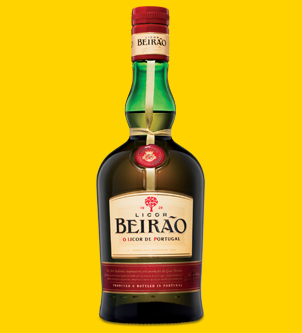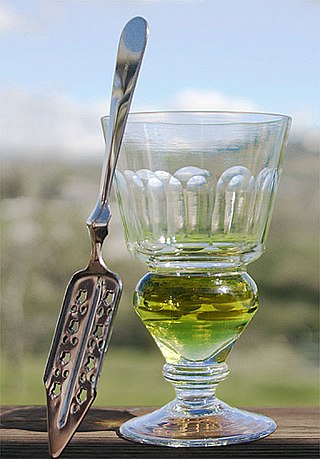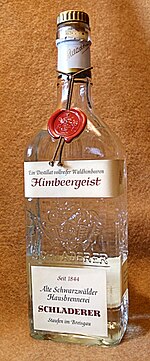
A liqueur is an alcoholic drink composed of spirits and additional flavorings such as sugar, fruits, herbs, and spices. Often served with or after dessert, they are typically heavily sweetened and un-aged, beyond a resting period during production, when necessary, for their flavors to mingle.

Brandy is a liquor produced by distilling wine. Brandy generally contains 35–60% alcohol by volume and is typically consumed as an after-dinner digestif. Some brandies are aged in wooden casks. Others are coloured with caramel colouring to imitate the effect of aging, and some are produced using a combination of aging and colouring. Varieties of wine brandy can be found across the winemaking world. Among the most renowned are Cognac and Armagnac from south-western France.

Cognac is a variety of brandy named after the commune of Cognac, France. It is produced in the surrounding wine-growing region in the departments of Charente and Charente-Maritime.

Akvavit or aquavit is a distilled spirit that is principally produced in Scandinavia, where it has been produced since the 15th century. Akvavit is distilled from grain or potatoes and is flavoured with a variety of spices and herbs. It is also popular in Northern Germany.
Schnapps or schnaps is a type of alcoholic beverage that may take several forms, including distilled fruit brandies, herbal liqueurs, infusions, and "flavored liqueurs" made by adding fruit syrups, spices, or artificial flavorings to neutral grain spirits.

Sloe gin is a British red liqueur made with gin and blackthorn fruits (sloes), which are the drupe fruit of the Prunus spinosa tree, which is a relative of the plum. As an alcoholic drink, sloe gin contains between 15 per cent and 30 per cent alcohol by volume (ABV); however, European Union regulations established 25 per cent ABV as the minimal alcoholic content for the blackthorn beverage to be a sloe gin. Historically, despite being a liqueur based upon gin, the EU included the colloquial name sloe gin to the legal definitions; thus, sloe gin is the only alcoholic beverage that legally uses the term gin without appending the liqueur suffix.

Kirschwasser, or just Kirsch, is a clear, colourless brandy from Germany, Switzerland, and France, traditionally made from double distillation of morello cherries. It is now also made from other kinds of cherries. The cherries are fermented completely, including their stones. Unlike cherry liqueurs and cherry brandies, Kirschwasser is not sweet. It is sometimes distilled from fermented cherry juice.

Grappa is an alcoholic beverage: a fragrant, grape-based pomace brandy of Italian origin that contains 35 to 60 percent alcohol by volume. Grappa is a protected name in the European Union.

Aguardente (Portuguese) or aguardiente (Spanish) is a type of distilled alcoholic spirit that contains between 29% and 60% alcohol by volume (ABV). It is a somewhat generic term that can refer to liquors made from various foods. It originates from and is typically consumed on the Iberian Peninsula and in Iberian America.

Liquor or distilled beverages are alcoholic drinks produced by the distillation of grains, fruits, vegetables, or sugar that have already gone through alcoholic fermentation. Other terms for liquor include spirit, spirituous liquor or hard liquor. While the word liquor ordinarily refers to distilled alcoholic spirits rather than beverages produced by fermentation alone, it can sometimes be used more broadly to refer to any alcoholic beverage.

Pálinka is a traditional fruit spirit with origins in the medieval Hungary, known under several names. Protected as a geographical indication of the European Union, only fruit spirits mashed, distilled, matured and bottled in Hungary and similar apricot spirits from four provinces of Austria can be called "pálinka", while "Tótpálinka" refers to wheat-derived beverages. Törkölypálinka, a different product in the legal sense, is a similarly protected pomace spirit that is commonly included with pálinka. While pálinka may be made of any locally grown fruit, the most common ones are plums, apricots, apples, pears, and cherries.

An eau de vie is a clear, colourless fruit brandy that is produced by means of fermentation and double distillation. The fruit flavor is typically very light.
Rectified spirit, also known as neutral spirits, rectified alcohol or ethyl alcohol of agricultural origin, is highly concentrated ethanol that has been purified by means of repeated distillation in a process called rectification. In some countries, denatured alcohol or denatured rectified spirit may commonly be available as "rectified spirit", because in some countries the retail sale of rectified alcohol in its non-denatured form is prohibited.

Absinthe is an anise-flavored spirit derived from several plants, including the flowers and leaves of Artemisia absinthium, together with green anise, sweet fennel, and other medicinal and culinary herbs. Historically described as a highly alcoholic spirit, it is 45–74% ABV or 90–148 proof in the US. Absinthe traditionally has a natural green color but may also be colorless. It is commonly referred to in historical literature as la fée verte'the green fairy'. While sometimes casually referred to as a liqueur, absinthe is not traditionally bottled with sugar or sweeteners. Absinthe is traditionally bottled at a high level of alcohol by volume, but it is normally diluted with water before being consumed.
Fruit brandy is a distilled beverage produced from mash, juice, wine or residues of edible fruits. The term covers a broad class of spirits produced across the world, and typically excludes beverages made from grapes, which are referred to as plain brandy or pomace brandy. Apples, pears, apricots, plums and cherries are the most commonly used fruits.

Gentian liqueur is a clear liqueur produced using the roots of the gentian plant.
Bierbrand is a liquor produced by distilling beer. Bierbrand produced in the European Union and Switzerland is required to contain at least 38% alcohol by volume and retain the flavor profile of beer. Additives such as neutral spirits or flavorings are prohibited, except for caramel color.

Geist is a distilled beverage obtained by maceration of unfermented fruit or other raw materials in neutral spirits, followed by distillation. This differs from fruit brandy, where the alcohol comes from fermenting the fruit's naturally occurring sugars. As such, geist can be made from a much wider range of materials, as it is not limited to fruits with sufficient fermentable sugars.














